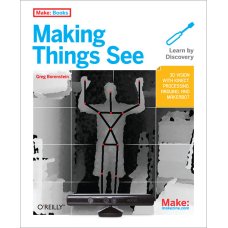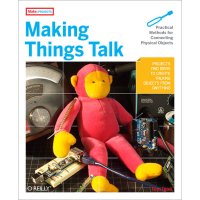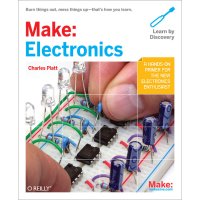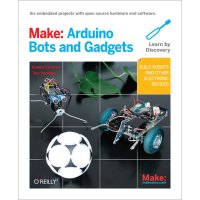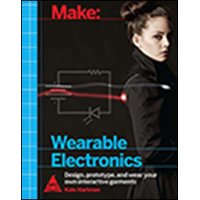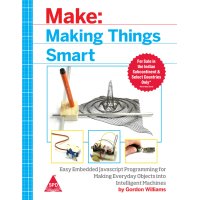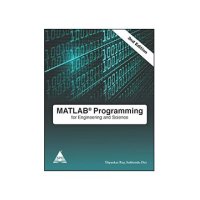This detailed, hands-on guide provides the technical and conceptual information you need to build cool applications with Microsoft’s Kinect, the amazing motion-sensing device that enables computers to see. Through half a dozen meaty projects, you’ll learn how to create gestural interfaces for software, use motion capture for easy 3D character animation, 3D scanning for custom fabrication, and many other applications.
Perfect for hobbyists, makers, artists, and gamers, Making Things See shows you how to build every project with inexpensive off-the-shelf components, including the open source Processing programming language and the Arduino microcontroller. You’ll learn basic skills that will enable you to pursue your own creative applications with Kinect.
- Create Kinect applications on Mac OS X, Windows, or Linux
- Track people with pose detection and skeletonization, and use blob tracking to detect objects
- Analyze and manipulate point clouds
- Make models for design and fabrication, using 3D scanning technology
- Use MakerBot, RepRap, or Shapeways to print 3D objects
- Delve into motion tracking for animation and games
- Build a simple robot arm that can imitate your arm movements
- Discover how skilled artists have used Kinect to build fascinating projects
About the Author
After a decade as a musician, web programmer, and startup founder, Greg Borenstein recently moved to New York to become an artist and teacher. His work explores the use of special effects as an artistic medium. He is fascinated by how special effects techniques cross the boundary between images and the physical objects that make them: miniatures, motion capture, 3D animation, animatronics, and digital fabrication. He is currently a grad student at NYU’s Interactive Telecommunications Program.
Chapter 1 What Is the Kinect?
- How Does It Work? Where Did It Come From?
- Kinect Artists
Chapter 2 Working with the Depth Image
- Images and Pixels
- Project 1: Installing the SimpleOpenNI Processing Library
- Project 2: Your First Kinect Program
- Project 3: Looking at a Pixel
- Converting to Real-World Distances
- Project 4: A Wireless Tape Measure
- Project 5: Tracking the Nearest Object
- Projects
- Project 6: Invisible Pencil
- Project 7: Minority Report Photos
- Exercises
Chapter 3 Working with Point Clouds
- What You’ll Learn in This Chapter
- Welcome to the Third Dimension
- Drawing Our First Point Cloud
- Making the Point Cloud Move
- Viewing the Point Cloud in Color
- Making the Point Cloud Interactive
- Projects
- Project 8: Air Drum Kit
- Project 9: Virtual Kinect
- Conclusion
Chapter 4 Working with the Skeleton Data
- A Note About Calibration
- Stages in the Calibration Process
- User Detection
- Accessing Joint Positions
- Skeleton Anatomy Lesson
- Measuring the Distance Between Two Joints
- Transferring Orientation in 3D
- Background Removal, User Pixels, and the Scene Map
- Tracking Without Calibration: Hand Tracking and Center of Mass
- Projects
- Project 10: Exercise Measurement
- Project 11: “Stayin’ Alive” Dance Move Triggers MP3
- Conclusion
Chapter 5 Scanning for Fabrication
- Scan and Print: Rapid Prototyping Objects
- Intro to Modelbuilder
- Intro to MeshLab
- Making a Mesh from the Kinect Data
- Looking at Our First Scan
- Cleaning Up the Mesh
- Looking at Our Corrected Model
- Prepping for Printing
- Reduce Polygons in MeshLab
- Printing Our Model on a MakerBot
- Sending Our Model to Shapeways
- Conclusion: Comparing Prints
Chapter 6 Using the Kinect for Robotics
- Forward Kinematics
- Inverse Kinematics
- Conclusion
Chapter 7 Conclusion: What’s Next?
- Beyond Processing: Other Frameworks and Languages
- Topics in 3D Programming to Explore
- Ideas for Projects
Appendix Appendix
- SimpleOpenNI Cheat Sheet
- Chapter 2
- Chapter 4
- Chapter 6
Colophon
Making Things See
- Brand: Make:
- Product Code: Bok-Making-Things-See
- Reward Points: 7
- Availability: 2 - 3 Days
-
रo 725.00
- Price in reward points: 725
Related Products
Making Things Talk: Practical Methods for Connecting Physical Objects
This book contains a series of projects that teaches readers what they need to know to get their cre..
रo 900.00
Make: Electronics
"This is teaching at its best!" --Hans Camenzind, inventor of the 555 timer (the world's most su..
रo 450.00
Make: Arduino Bots and Gadgets
Want to build your own robots, turn your ideas into prototypes, control devices with a com..
रo 650.00
Make: Wearable Electronics
What if your clothing could change color to complement your skin tone, respond to your racing heartb..
रo 475.00
Making Things Smart
All Indian Reprints of Maker Media are printed in Grayscale. Making Things Smart teaches t..
रo 750.00
MATLAB Programming - 2nd Edition
About the Book MATLAB Programming for Engineering and Science is written with the intent..
रo 500.00
Tags: Book, Making Things See, Greg Borenstein

